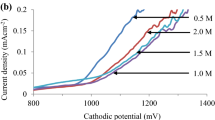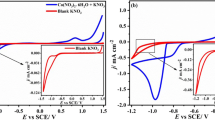Abstract
The electrocrystallization of Cd on previously anodized Ti substrates was studied by means of electrochemical techniques and SEM images in three different solutions of CdSO4 (2, 10, and 50 mM). Voltammetric characterization showed the typical behavior of metal electrodeposition on conducting substrates, and potentials for electrodeposition of Cd were identified. However, the response obtained at different potentials in current transients exhibited an abnormal behavior suggesting the influence of TiO2 on the process of electrocrystallization. The characterization of the obtained electrodeposits by SEM images allowed relating electrochemical with morphological changes, in particular, variations in the crystal size and shape as well as formation of presumably Cd branches on the substrate surface. This behavior only allowed the analysis of current transients of the electrodeposits obtained in 2 mM CdSO4 solution using general equation for diffusion-controlled 3D growth and relating parameters of Cd crystal growth on anodized Ti electrode with the observed morphological changes.









Similar content being viewed by others
References
Henderson MA (2011) Surf Sci Rep 66:185–297
Kosanovic T, Jaroussos D, Bouroushian M (2010) J Solid State Electrochem 14:241–248
Kuznetsov VN, Serpone N (2009) J Phys Chem C 113:15110–15123
Teh CM, Mohamed AR (2011) J Alloys Comp 509:1648–1660
Smirnova N, Vorobets V, Linnik O, Manuilov E, Kolbasov G, Eremenko A (2010) Surf Interface Anal 42:1205–1208
Chiarello GL, Aguirre MH, Selli E (2010) J Catal 273:182–190
Gunawardena G, Hills G, Montenegro I (1985) J Electroanal Chem 184:371–389
Delplancke J-L, Sun M, O’Keefe TJ, Winand R (1989) Hydrometallurgy 23:47–66
Delplancke J-L, Ongaro M, Winand R (1992) J Appl Electrochem 843-851
Zhang J, Kuo-Shi T, O’Keefe TJ (1997) Surf Coat Technol 89:225–232
Zhou Z, O’Keefe TJ (1998) J Appl Electrochem 28:461–469
Teng KS, Delplancke J-L, Zhang J, O’Keefe TJ (1998) Metal Mater Trans B 29:749–755
Kim S-B, Kim K-T, Park C-J, Kwon H-S (2002) J Appl Electrochem 32:1247–1255
Chang HK, Choe BH, Lee JK (2005) Mater Sci Eng, A 409:317–328
Ryu WH, Park CJ, Kwon HS (2010) J Nanosci Nanotech 10:1–4
Xie K, Sun L, Wang C, Lai Y, Wang M, Chen H, Lin C (2010) Electrochim Acta 55:7211–7218
Xie K, Wu Q, Wang Y, Guo W, Wang M, Sun L, Lin C (2011) Electrochem Commun 13:1469–1472
Shpaisman N, Givan U, Patolsky F (2010) ACS Nano 4:1901–1906
Sarma B, Smith YR, Swomitra KM, Misra M (2012) Mater Lett 85:33–36
Acevedo-Peña P, Vázquez G, Laverde D, Pedraza-Rosas JE, González I (2010) J Solid State Electrochem 14:757–767
Marino CEB, de Oliveira EM, Rocha-Filho RC, Biaggio SR (2001) Corros Sci 43:1465–1476
Berger T, Monllor-Satoca D, Jankulovska M, Lana-Villarreal T, Gómez R (2012) ChemPhysChem 13:2824–2875
Zarębska K, Skompska M (2011) Electrochim Acta 56:5731–5739
Barrera E, Palomar-Pardavé M, Batina N, González I (2000) J Electrochem Soc 147:1787–1796
Vazquez-Arenas J, Vázquez G, Meléndez AM, González I (2007) J Electrochem Soc 154:D473–D481
Miranda-Hernández M, Palomar-Pardavé M, Batina N, González I (1998) J Electroanal Chem 443:81–93
Scharifker BR, Mostany J, Palomar-Pardavé M, González I (1999) J Electrochem Soc 146:1005–1012
Palomar-Pardavé M, González I, Batina N (2000) J Phys Chem B 104:3545–3555
Miranda-Hernández M, González I, Batina N (2001) J Phys Chem B 105:4214–4223
Abd El-Halim AM, Sobahi MI, Baghlaf AO (1983) Surf Technol 18:225–232
Barnard R, Edwards GS, Holloway J, Tye FL (1983) J Appl Electrochem 13:751–764
Abd El-Halim AM (1984) J Appl Electrochem 14:587–594
Montiel T, Solorza O, Sánchez H (2000) J Electrochem Soc 147:1031–1037
Dolati A, Afshar A, Ghasemi H (2005) Mater Chem Phys 94:23–28
Ahmed MF, Pushpanaden F (1977) J Cryst Growth 41:77–83
Itoh S, Yamazoe N, Seiyama T (1977) Surf Technol 5:27–42
Nikolić LN, Čekerevac MI, Popov KI (1988) Surf Coat Technol 34:219–229
Popov KI, Čekerevac MI (1989) Surf Coat Technol 37:435–440
Čekerevac MI, Popov KI (1989) Surf Coat Technol 37:441–447
Dogonadze RR, Kuznetsov AM, Ulstrup J (1977) Electrochim Acta 22:967–975
Palomar-Pardavé M (1995) MSc. Thesis, Universidad Autónoma Metropolitana–Iztapalapa, Ciudad de México
Kariuki S, Dewald HD (1996) Electroanal 8:307–313
Acknowledgments
This work has been given the financial support by CONACyT (Project CB-2008/105655). J. Edgar Carrera-Crespo and Próspero Acevedo-Peña are grateful to CONACyT for their grants for postgraduate studies. The authors thank to Ing. Rogelio Morán Elvira from CIE-UNAM and to the Laboratorio Central de Microscopía Electrónica from UAM-I, for the SEM images.
Author information
Authors and Affiliations
Corresponding author
Additional information
“Paper submitted to the special issue in celebration of the 70th birthday of Prof. Dr. Alexander Milchev”
We dedicate this paper to Professor Milchev for his contribution on the electrochemical nucleation and growth and especially for his great human qualities.
Appendix
Appendix
Procedure for non-linear adjustment
Equations (3) and (7) were used to make non-linear adjustments of experimental current transients. This appendix shows, just by way of example, the procedure of non-linear adjustment used for Eq. (3).
Equation (3) was parameterized in the following manner:
where:
\( P1=\frac{nFc }{{{\pi^{{{1 \left/ {2} \right.}}}}}} \), P2 = D, P3 = πk, P4 = N o, P5 = A
The development of non-linear adjustments was performed using Statistica software version 5, which requires initial values for every parameter shown in Eq. (8); these parameters were estimated taking into consideration the following:
-
For P1: the values of n, F and c do not vary during the experimentation, so P1 = constant value = 0.218.
-
For P2: the average of D values estimated by Cottrell equation was used as initial value (1.97 × 10−5).
-
For P3: since k does not vary during the experimentation, P3 was maintained constant at a value of 0.080.
-
For P4 and P5: in order to estimate the initial values of these parameters, we considered equations defining i m (maximum current) for instantaneous nucleation (Eq. (9)) and progressive diffusion-limited 3D nucleation (Eq. (10)).
Rights and permissions
About this article
Cite this article
Carrera-Crespo, J.E., Acevedo-Peña, P., Miranda-Hernández, M. et al. Electrocrystallization of cadmium on anodically formed titanium oxide. J Solid State Electrochem 17, 445–457 (2013). https://doi.org/10.1007/s10008-012-1975-1
Received:
Revised:
Accepted:
Published:
Issue Date:
DOI: https://doi.org/10.1007/s10008-012-1975-1




